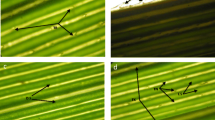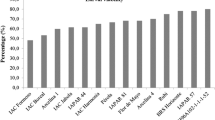Abstract
The biology of Maruca testulatis Geyer was studied on different parts of 18 cowpea cultivars to determine the role of antibiosis in their levels of resistance. M. testulalis larvae were successfully reared from first instar to adult stage on floral buds, flowers and sliced pods, but not on stems, terminal shoots and intact (unsliced) pods, where there was complete larval mortality. The mean pupal weight ranged from 43.5–54.5 mg on floral buds, 38.5–58.6 mg on flowers and 42.7–58.6 mg on sliced pods, with highly significant differences between (P < 0.01) resistant and susceptible cultivars on each part. Growth indices showed that sliced pods were the most suitable for larval growth and development, followed by flowers and floral buds.
The levels of resistance found were inadequate for solving the M. testulalis problem in cowpea. Selection and breeding for cowpea ideotypes (architypes), to combine such resistance with morphological, biochemical and biophysical traits, could enhance the low levels of resistance in the cowpea crop and ultimately lead to the effective management of this pest. The correlations between growth and development parameters showed that larval period had the most influence on M. testulalis survival and population build-up in the succeeding generations.
Résumé
La biologie de Maruca testulalis a été étudié sur différentes parties des 18 variétés du niébé pour déterminer le rôle de l’antibiosis sur les niveaux de résistance. Des larves du M. testulalis ont été multipliées en masse avec succès à partir du stade larvaire au stade adulte sur les boutaux floraux, les fleurs ainsi que sur les gousses dissequées mais non pas sur les tiges, bourgeons terminaux et les gousses intactes où était une mortalité complète. Les poids moyens des pupes oscillaient entre 43,5 et 54,5 mg sur les boutaux floraux; 38,5–58,6 mg sur les fleurs et 42,7–58,6 mg sur les gousses dissequées avec une difference hautement significative (P < 0, 01) entre les variétés résistantes et susceptibles de chaque partie. Les indices de croissance ont montré que les gousses dissequées étaient les meilleures pour la croissance et le développement larvaires, suivies des fleurs et des boutaux floraux. Les niveaux de résistance trouvés n’étaient pas souffisants pour résoudre le problème de M. testulalis du niébé. La séléction et le croisement des idéotypes (architypes) du niébé pour combiner telle résistance avec les traits morphologiques, biochimiques et biophysiques renforceraient des bas niveaux de resistance du niébé apportant ainsi un control efficace de cet insecte. La corrélation entre les paramètres de croissance et de développement montrait que le stade larvaire avait plus d’influence sur la survie et la croissance de la population de M. testulalis sur les générations futures.
Similar content being viewed by others
References
Howe R. W. (1971) A parameter for expressing the suitability of an environment for insect development. J. Stored Prod. Res. 7, 63–65
International Institute of Tropical Agriculture (IITA) (1976) Entomology: Host plant resistance in cowpea. Annual Report for 1975 pp. 29. IITA, Ibadan, Nigeria.
IITA (1989) Biotechnology. AnnualReportfor 1988/1989. IITA, Ibadan, Nigeria, pp.23–26.
Jackai L. E. N. (1981) Relationship between cowpea crop phenology and field infestation by the legume pod borer, Maruca testulalis. Ann. Entomol. Soc. Am. 74, 402–408.
Jackai L. E. N. (1982) A field screening technique for resistance of cowpea (Vigna unguiculata) to the pod borer Maruca testulalis (Geyer) (Lepidoptera: Pyralidae). Bull. Entomol. Res. 72, 145–156.
Jackai L. E. N. (1983) Efficacy of insecticide application at different times of day against the legume pod borer Maruca testulalis (Geyer) (Lepidoptera: Pyralidae), on cowpea in Nigeria. Prot. Ecol. 5, 245–251.
Jackai L. E. N. and Oghiakhe S. (1989) Pod wall trichomes and resistance of two wild cowpea, Vigna vexillata, accessions to Maruca testulalis (Geyer) (Lepidoptera: Pyralidae) and Clavigralla tomentosicollis Stal. (Hemiptera: Coreidae). Bull. Entomol. Res. 79, 595–605.
Jackai L. E. N. and Raulston J. R. (1988) Rearing the legume pod borer Maruca testulalis Geyer (Lepidoptera: Pyralidae) on artificial diet. Trop. Pest. Manage. 34(2), 168–172.
Jotwani M. G., Chaudhari S. and Singh S. P. (1978) Mechanism of resistance to Chilo partellus Swinhoe in sorghum. Indian J. Entomol. 40, 273–276.
Ochieng’-Odero J. P. R. (1990) New strategies for quality assessment and control of insect produced in artificial rearing systems. Insect Sci. Applic. 11, 133–141.
Oghiakhe S. (1990) Resistance screening, biology and behaviour of Maruca testulalis Geyer (Lepidoptera: Pyralidae) on cowpea, Vigna unguiculala (L.) Walp. Ph.D. Thesis, University of Lagos, Akoka-Yaba, Lagos, Nigeria.
Oghiakhe S., Jackai L. E. N. and Makanjuola W. A. (1991a) Anatomical parameters of cowpea, Vigna unguiculata (L.) Walp. stem and pod wall resistance to the legume pod borer Maruca testulalis Geyer (Lepidoptera: Pyralidae). Insect Sci. Applic. 12, 171–176.
Oghiakhe S., Jackai L. E. N. and Makanjuola W. A. (1994b) Cowpea plant architecture in relation to infestation and damage by the legume pod borer, Maruca testulalis Geyer (Lepidoptera: Pyralidae) — 1. Effect of canopy structure and pod position. Insect Sci. Applic. 12, 193–199.
Oghiakhe S., Jackai L. E. N. and Makanjuola W. A. (1992a) Pod wall toughness has no effect on cowpea resistance to the legume pod borer Maruca testulalis Geyer (Lepidoptera: Pyralidae). Insect Sci. Applic. 13, 345–349.
Oghiakhe S., Jackai L. E. N. and Makanjuola W. A. (1992b) Cowpea plant architecture in relation to infestation and damage by the legume pod borer, Maruca testulalis Geyer (Lepidoptera: Pyralidae)— 2. Effect of pod angle. Insect Sci. Applic. 13, 339–344.
Oketch S. H. O. (1986) Colonizing responses of Maruca testulalis (Geyer) (Lepidoptera: Pyralidae) to different cowpea culti vars in relation to their resistance/susceptibility. Ph.D. Thesis, Rivers State University of Science and Technology, Porthacourt.
Oketch S. H. O. and Saxena K. N. (1990) Responses of Maruca testulalis (Lepidoptera:Pyralidae) larvae to variably resistant cowpea cultivars. Environ. Entomol. 19, 1792–1797.
Otieno D. A., Moreka L. and Nyandat E. (1985) Chemical aspects of cowpea resistance to the pod borer, Maruca testulalis (Geyer). The ICIPE Thirteenth Annual Report, pp. 63–64.
Painter R. H. (1951) Insect Resistance in Crop Plants. Macmillan, London.
Painter R. H. (1958) Resistance of plants to insects. Annu. Rev. Entomol. 3, 267–290.
Singh S. R. (1978). Resistance to pests of cowpeas in Nigeria. In Pests of Grain Legumes: Ecology and Control (Edited by Singh S.R., van Emden H.F. and Taylor T.A.), pp. 267–279. Academic Press, Inc., New York.
Singh B. U. and Rana B. S. (1984) Influence of varietal resistance on oviposition and larval development of stalkborer, Chilo partellus Swin., and its relationship to field resistance in sorghum. Insect Sci. Applic. 5, 286–296.
Singh S. P. and Verma A. N. (1988) Antibiosis mechanism of resistance to stem borer, Chilo partellus (S winhoe) in sorghum. Insect Sci. Applic. 9, 579–582.
Taylor T. A. (1965) Observations on the bionomics of Laspeyresia ptychora Meyr. (Lepidoptera: Eucosmidae) infesting cowpea in Nigeria. Bull. Entomol. Res. 55, 761–773.
Taylor T. A. (1978) Maruca testulalis: an important pest of tropical grain legumes. In Pests of Grain Legumes: Ecology and Control (Edited by Singh S.R., van Emden H.F. and Taylor T.A.) pp. 193–200, Academic Press. Inc., New York
Slansky F., Jr. (1982) Insect Nutrition: An adaptationists’ perspective. Florida Entomol. 65, 46–71.
Author information
Authors and Affiliations
Rights and permissions
About this article
Cite this article
Oghiakhe, S., Makanjuola, W.A. & Jackai, L.E.N. Antibiosis Mechanism of Resistance to the Legume Pod Borer, Maruca Testulalis Geyer (Lepidoptera: Pyralidae) in Cowpea. Int J Trop Insect Sci 14, 403–410 (1993). https://doi.org/10.1017/S1742758400014934
Received:
Revised:
Published:
Issue Date:
DOI: https://doi.org/10.1017/S1742758400014934




